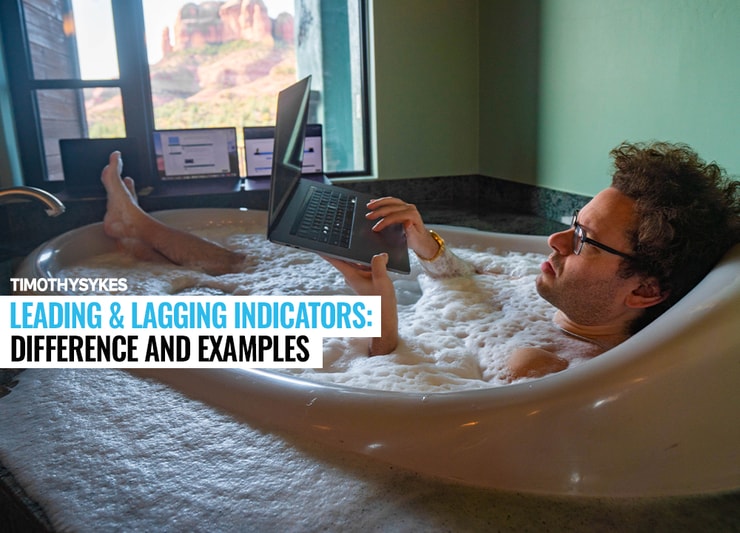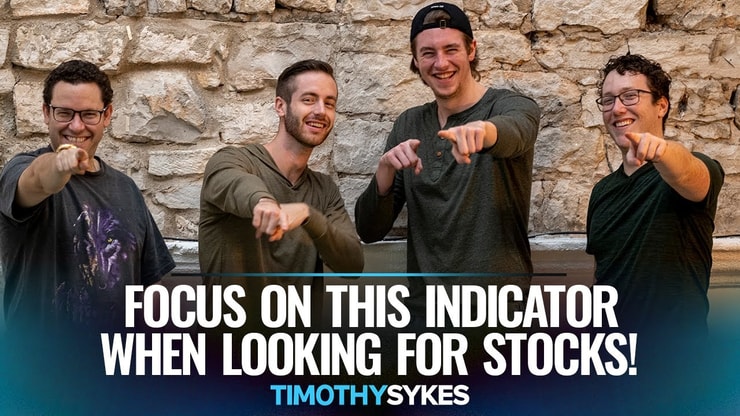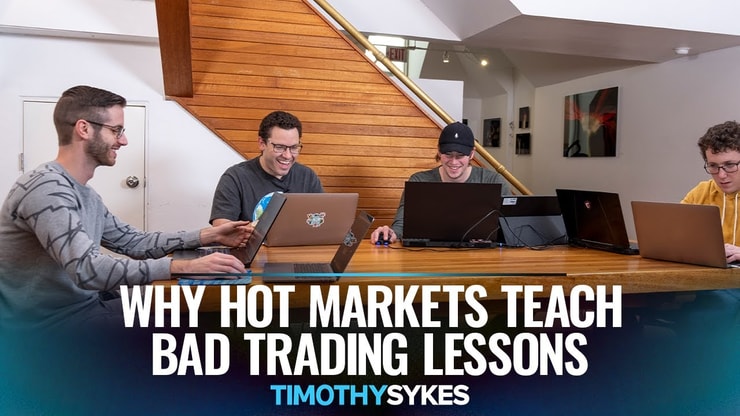What’s the difference between leading and lagging indicators?
A lot of traders ask me this. They want a quick and easy answer so they know which indicators to pay attention to.
Sorry, but there isn’t an easy answer here.
But I can tell you that only looking at one indicator is account suicide. Have you ever pulled onto a highway with just a gas pedal? Of course not. You need a steering wheel, brakes, mirrors, a seat belt, and so on.
Trading is the same. You need to diversify the indicators you use. They all have a different purpose. And when you put it all together, you get a more accurate picture of the market.
So how do you diversify?
Lucky for you there are lots of ways to classify indicators for technical analysis. One simple way is identifying whether an indicator is leading or lagging. A combination of the two can help traders stay safe and take only the best trades.
How many indicators you use is your choice. But don’t stunt your education by only learning one or two. That’s setting yourself up for failure.
Today, discover the two types of indicators. Then you can apply that knowledge to your trading plan going forward. It’s all about developing a solid education foundation.
Table of Contents
Leading and Lagging Indicators: What’s the Difference?

The best traders I know look at multiple indicators before making a trade. There’s a lot of indicators out there. Part of your job is to pick the right ones for you and your strategy.
When I was starting I tested hundreds of different combinations. It’s hard work and takes a lot of time.
I narrowed it down to seven indicators that make up the Sykes’ Sliding Scale. (More on that shortly.) I teach all my students how to use it. But feel free to switch it up. What works for me might not work for you.
The key is studying enough to find your sweet spot. Too few indicators and you’re trading blind … Too many and you’ll overanalyze.
Find those that work best for you. You can start by testing a combination of leading and lagging indicators. Most indicators fall into one of these categories.
Leading Indicators
Dust off your crystal ball … Traders use these to try to predict the future.
Think about it like this — to lead means to be in front. These indicators use current market data to guess what a stock could do next.
Don’t get too excited.
The data constantly changes. So these indicators are likely to send false signals now and then.
If they worked perfectly, millionaires would be a dime a dozen. The reality is the vast majority of traders lose. So using more than one leading indicator can help give you a clearer picture.
Another great way to use leading indicators for safe trades is to pair them with…
Lagging Indicators
These focus on past market data.
You might be thinking, “Tim, why would I want to know where the stock has been? I can’t trade in the past.”
You’re right. But studying the past can help traders make better decisions about the trend.
Ever heard the phrase “past performance is not indicative of future results?”
I agree with the sentiment. Just because a stock has run before doesn’t mean it will run again. But it can. In penny stock land I’ve seen the same stocks spike over and over with the same patterns.
Sometimes it makes me feel like I’m taking crazy pills…
For 20+ years I’ve been trading the same setups on the same sketchy stocks. They’re not always identical. But my experience helps me notice when a stock starts behaving in a familiar way. That’s when I pay attention.
Watching the indicators is only part of the equation … You have to know how to use them.
How to Use Leading and Lagging Indicators When Trading

It’s all about making your most educated guess. You have to enter trades safely and recognize when to get out.
Some people treat the market like a slot machine. This isn’t gambling! That’s the wrong attitude.
Always have a strategy when you enter a trade and keep things in perspective. Use leading and lagging indicators to help you do that.
And know that even the best traders are wrong sometimes. It happens. Get used to losing. All the due diligence in the world won’t save you from a trade gone bad.
Stubborn traders don’t last long. One of two things happens — either they learn how to take small losses or they blow up their accounts.
I’ve seen it happen too many times. Some newbie gets lucky a few times, then starts to count on unrealized profits. Usually, that’s when the market humbles them.
Don’t be that newbie.
Let’s run through the Sykes’ Sliding Scale as an example. I’ll tell you which of my indicators are leading vs. lagging. If you’re unfamiliar with the scale, take a second to study up.
(Pro tip: You can learn the Sykes’ Sliding Scale in my “Trader Checklist Part Deux” DVD.)
Examples of Leading Indicators
Before I enter a trade, I always check my risk/reward ratio. How much money am I risking? Are the potential profits worth the risk?
This is a leading indicator because I’m attempting to predict the future of the trade. If the trade goes bad, how much will I lose? And if it goes well, how much could I reasonably stand to profit?
Next, I check how easy it is to get in and out of the trade or the liquidity. This indicator is both leading and lagging, but I’ll explain the leading aspect first.
Level 2 shows me instantly how many shares are available to trade. If there aren’t enough shares to buy, I’ll sit on my hands. I hate getting stuck in an illiquid stock. If it’s hard to open my position, it will probably be hard to get out of it too.
I never trade without Level 2. It’s a huge part of my daily strategy.
Another indicator I watch is time — specifically the time of day and my personal schedule.
The hottest market hours are at the open and the close. I don’t usually trade midday. By not trading around noon, I’m predicting there won’t be any plays worth watching. I also won’t take a trade if I have a busy schedule. So my prediction is that I won’t have enough time to trade.
The last leading indicator I check is why the stock is moving. What’s the catalyst? Certain types of news can spike stocks higher than others. It is important to understand why a stock is moving to keep your expectations realistic.
Examples of Lagging Indicators
The most obvious lagging indicator is a stock’s pattern and price. Where was the price in the past? Does it look like it’s following a pattern? I look at stock charts to confirm trends and recognize strategies.
Remember how I said the ease of entry and exit is both a leading and lagging indicator?
That’s why it’s important to trade liquid stocks. You don’t want to be the trader buying 50% of the float. Getting out of that position would be a nightmare. Pay attention to the volume traded, the market cap, and shares outstanding. They help determine a stock’s liquidity.
The past performance and history of spiking is another obvious lagging indicator. It’s basically in the name. If the stock has a history of volatility, it’s possible it could become volatile again.
Last, I always pay attention to the market as a whole. Three out of four stocks follow the overall market. So if the market’s up, there’s a better chance stocks will spike. If the market’s down, I’m more careful going long.
Is the Stock Market a Leading or Lagging Indicator?
Pssst … look at the previous section. Watching the stock market as a whole is a great way to make better-informed trades.
It’s harder for stocks to spike in bear markets.
That’s why bull markets are a fan favorite. Unless you’re a short seller.
I don’t short much anymore since I began teaching students how to trade. I noticed short selling is more difficult for newbies to learn. It’s definitely riskier and it’s an overcrowded niche these days.
Some of my students do well shorting. Take Tim Lento for example. He’s coming up on $1 million in trading profits from mainly shorting stocks.*
Maybe shorting is for you. That’s fine. Learn as much as possible about long and short positions before deciding what works best.
Best Leading and Lagging Indicators for Day Trading

Be wary of anyone who tells you they have a perfect trading system. They’re lying. The market is unpredictable and inherently risky.
It all comes down to what works for you. I teach the Sykes Sliding Scale to my students because I’ve used it to safely profit for over two decades.**
But my way isn’t the only way. My best advice is to learn what other successful traders are doing. To me, the best traders hone their strategies based on what works for them. They have their own rules to follow.
Practice watching how indicators react with different stocks. Look for patterns.
Remember to always double- and triple-check your strategy before making a trade.
The Leading and Lagging Indicators Conclusion
It’d be nice if you only had to pay attention to one indicator. But you’re kidding yourself if you think that’ll work.
The stock market is a risky place where only the most prepared and disciplined survive. Technical analysis can help traders make better decisions…
Multiple indicators can help you see the bigger picture. So it matters which indicators you use. And the right ones for you will depend on the strategy you build. So try to diversify them to view the market from different angles.
Sorting them by leading and lagging is just one way to do it. But it’s a good start.
Feel free to use the Sykes’ Sliding Scale but know that it’s not a foolproof system. Trading isn’t an exact science. It’s up to you to figure out what works to your advantage.
If there’s an indicator you like that I don’t use, that’s fine. We’re all different and we might trade differently. We don’t have to pay attention to the same indicators. That’s the beauty of it.
If you want to learn more about how I use indicators to day trade penny stocks, apply for my Trading Challenge. I don’t accept everyone. You have to prove you’re ready to do the work. But it’s where all my millionaire students studied for years. And now you have a chance to learn from them and me.
Start studying today!
I want to know what you think! Which leading and lagging indicators do you use to trade? Comment below. I love to hear from you.
Disclaimers
*Please note that these kinds of trading results are not typical. Most traders lose money. It takes years of dedication, hard work, and discipline to learn how to trade. Individual results will vary. Trading is inherently risky. Before making any trades, remember to do your due diligence and never risk more than you can afford to lose.
**Please note: My results are far from typical. Individual results will vary. Most traders lose money. I have the benefit of years of hard work, dedication, and experience. Trading is inherently risky. Do your due diligence and never risk more than you can afford to lose.








Leave a reply